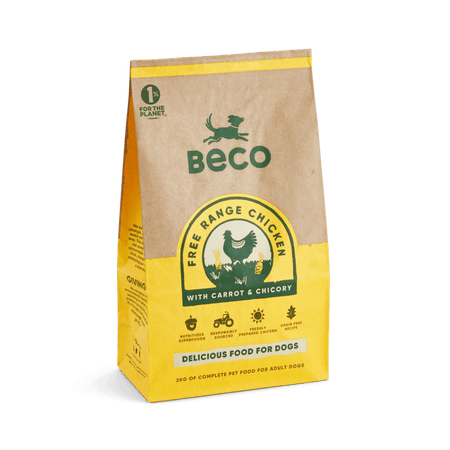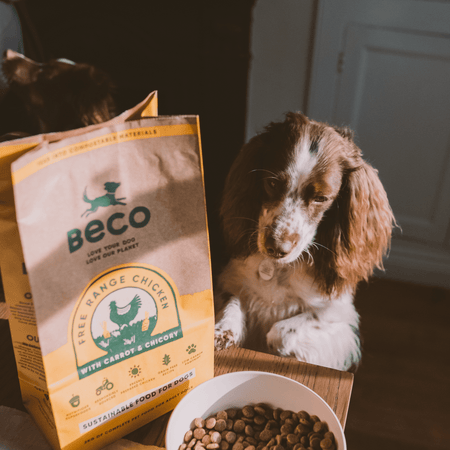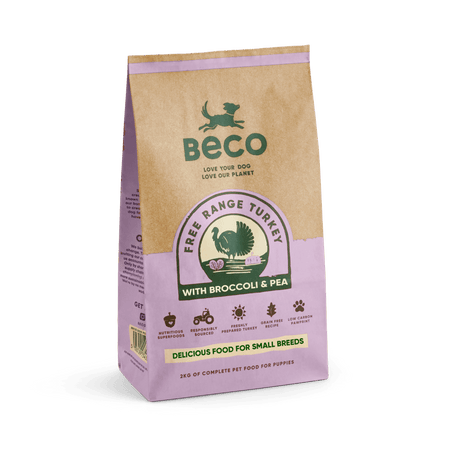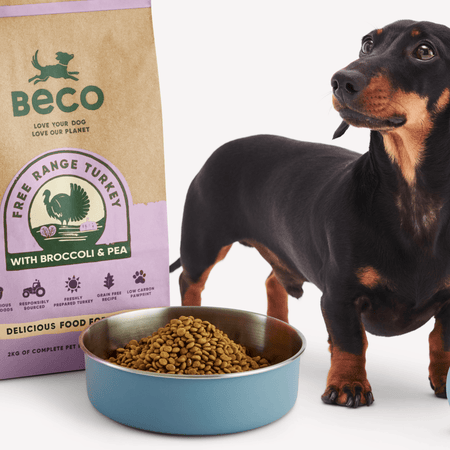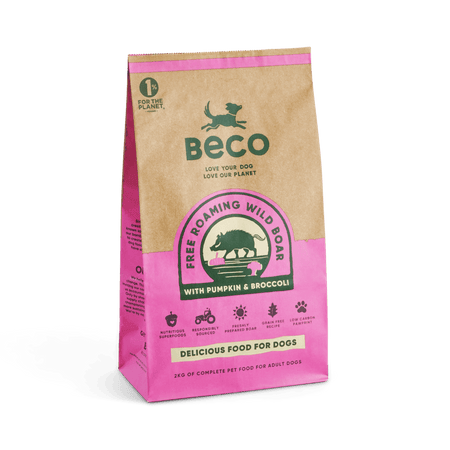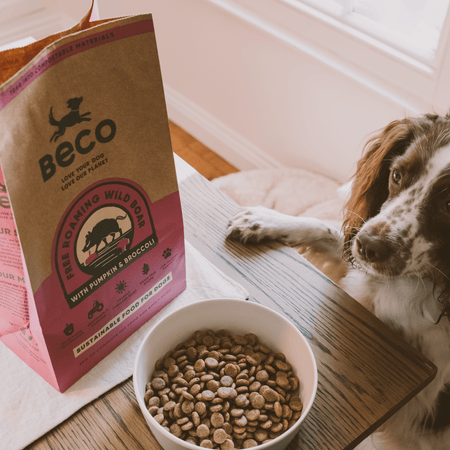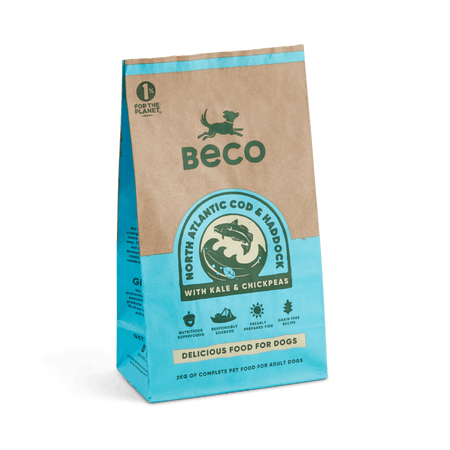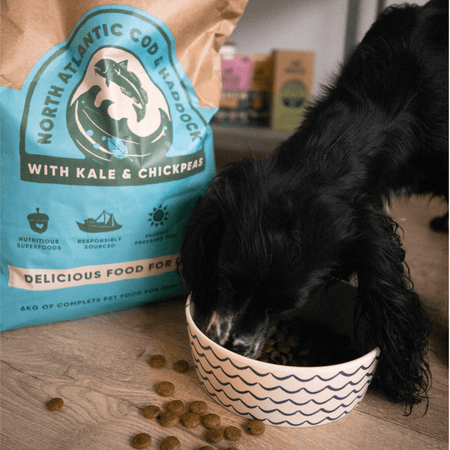Knowing what goes into our furry friends' food is very important. A lot of dog food companies use ambiguous labels to mislead consumers about the quality, but we’re here, to help you decode these labels to ensure you make the best choices for your dog's diet.
Key Summary
- Check for high-quality ingredients like lean proteins, whole grains, fruits, and vegetables.
- Some brands use vague ingredient descriptions to cover up poor quality in dog food.
- The FEDIAF Pet Food Labelling Guide helps ensure the safety and transparency of pet food products.
- Understanding kcal (kilocalories) in dog food is vital for managing your dog's weight.
How to read dog food labels
Dog food labels are divided into several sections that provide important information about the product. Understanding how these sections are broken up and the information each provides is key to analysing the quality of your dog's food. Let’s take a closer look:
How do I know if my dog needs a probiotic?
When considering breed-specific dog food, it's important to weigh up the pros and cons of whether they are a worthwhile investment for you and your pet.
1. Know your ingredients
The ingredients list is the first thing you should look at. Ingredients are listed in descending order by weight, so the food's first few ingredients are the most abundant.
TOP TIP: The "25% Rule" - For products with names like "Beef Dinner for Dogs", the named ingredient must make up at least 25% of the total weight, excluding water.
Look for natural ingredients like real meat, whole grains, and vegetables. Avoid foods that contain fillers, artificial additives, and preservatives, as these can harm your pet and the environment.

Best Ingredients to Look Out For
Not all dog food ingredients are created equal. Some provide essential nutrients, while others may be nothing more than fillers. Understanding the ingredients can help you pick high-quality food for your furry friend.
Lean Proteins
Look for ingredients like chicken, turkey, fish, and lean cuts of beef. These proteins have essential amino acids that help support your dog's muscles and organs.
Whole Grains
Contrary to popular belief, grains can be a valuable source of nutrition for dogs as long as they're whole grains. Ingredients like brown rice, oats, quinoa, and barley contain fibre, vitamins, and minerals that support digestive health and energy levels.
Dog food with whole grains helps reduce the reliance on processed ingredients and promotes sustainable agriculture practices.
Fruits and Vegetables
Like us, dogs can benefit from a diet rich in fruits and vegetables. Sweet potatoes, carrots, spinach, and blueberries have antioxidants, vitamins, and minerals that support immune function.
Natural Preservatives
Preservatives are often necessary to keep dog food fresh, but not all preservatives are created equal. Look for dog foods that use natural preservatives like mixed tocopherols (vitamin E) and rosemary extract rather than artificial additives like BHA, BHT, and ethoxyquin.
Natural preservatives are not only safer for your pet but also better for the environment, as they're less likely to contribute to pollution and ecosystem disruption.
2. Examine the guaranteed analysis
The guaranteed analysis provides information about the nutrient content of the food. Look for foods with high-quality, sustainably sourced protein sources, such as free-range chicken or MSC wild-caught fish.
You'll typically see protein, fat, fibre, and moisture values.

Protein
Protein is essential for your dog's overall health and well-being. It's the building block of muscles, tissues, and organs, providing the energy they need to thrive.
When studying the guaranteed analysis, look for a protein content that aligns with your dog's needs. High-quality proteins like real meat should be at the top of the list.
Fat
When examining the guaranteed analysis, consider the fat content of the food and whether it matches your dog's needs. Fat provides a concentrated source of energy, and it helps maintain a healthy skin and coat. Opt for sources of healthy fats like fish oil or chicken fat.
Fibre
Fibre may not get as much attention as protein and fat, but it's equally important for your dog's health. It supports digestive health, regulates bowel movements, and can even help manage weight . Look for moderate fibre content in your dog's food to promote a healthy digestive system.
Moisture
Moisture is simply the amount of water present in the food. While it may not seem as important, adequate hydration is necessary for your dog's overall health. Choose foods with a moderate moisture content to ensure your pup stays hydrated throughout the day.
Make Better Choices
Choose brands that use responsibly sourced ingredients to minimise their environmental impact. You don’t only want what's best for your pet but also what's best for the planet.
3. Check for certifications
Check for certifications that indicate the food meets specific standards for quality and sustainability. Common certifications to look out for include
The Marine Stewardship Council (MSC) certification indicates that the seafood ingredients are sustainably sourced.
Non-GMO Project Verified means that the dog food does not contain genetically modified organisms (GMOs).
The B-Corp certification is given to companies that meet high standards of social and environmental performance, transparency, and accountability.
These certifications can help you make better choices about the environmental impact of the food you're feeding your dog.
4. Research the company
Before purchasing dog food, take some time to research the company behind the brand. Look for brands committed to transparency in their sourcing and manufacturing practices.
The PUBMED website is a useful starting point for researching claims made by dog food brands.
The role of crude fat in dog food
Crude fat is the type of fat found in dog food that comes from animal fats, vegetable oils, and fish oils.
A minimum crude fat content of 5.5% for adult dog food and 8.5% for puppy food is recommended. It's an essential component of your dog's diet, providing them with energy and supporting various bodily functions.
Why is crude fat important?
Crude fat helps maintain healthy skin and coat, supports brain function, and provides a concentrated energy source. Without enough fat in their diet, dogs may experience dry, itchy skin, dull coats, and laziness.
Finding the right balance
While fat is necessary for your dog's health, you need to find the right balance.
Too much fat can lead to weight gain and obesity, while too little can result in multiple deficiencies. The ideal amount of crude fat in your dog's diet depends on their age, breed, activity level, and overall health.
Choose quality over quantity
Opt for foods that use high-quality fats, such as omega-3 fatty acids from fish oil or mono-unsaturated fats from olive oil. These fats provide essential nutrients and have additional health benefits for your dog.
Meat meal and novel proteins
You may have come across the term “meat meal” while scanning dog food labels. It’s a concentrated form of protein derived from rendered animal tissues. It's what's left over after the fat and moisture have been extracted from meat.
Although it may not sound appetising to us, meat meal is a valuable ingredient in dog food because of its high protein content. However, meat meals are a more efficient use of resources since they utilise parts of the animal that might otherwise go to waste.
Incorporating meat meals into dog food allows manufacturers to reduce their reliance on whole cuts of meat, thereby decreasing the environmental footprint of their products.
Novel proteins: A more sustainable alternative
For dogs with food sensitivities or allergies, novel proteins can provide a welcome solution. Unlike traditional protein sources like chicken or beef, novel proteins come from less commonly used sources such as duck, venison, or kangaroo.
Novel proteins offer unique nutritional benefits for your dog, making them a win-win for both your pet and the planet. They help reduce the environmental strain associated with conventional meat production.
By-products in dog food: What you need to know
By-products often get a bad rep, but they can be a valuable source of nutrition for dogs .
The value of by-products
Organs like the liver and kidneys are rich in vitamins and minerals, while bones provide essential calcium and phosphorus. Incorporating these parts into dog food can create balanced and nutritious recipes that support overall health and well-being.
Quality matters
While high-quality by-products can provide valuable nutrients, low-quality by-products may offer little to no nutritional value.
When choosing dog food, it's important to look for products that use high-quality ingredients, including by-products sourced from reputable suppliers. This ensures that your dog receives the best possible nutrition without compromising on quality.
FEDIAF pet food labelling guide
If you're a conscientious pet owner who cares about what goes into your furry friend's food bowl, you'll want to know about the FEDIAF Pet Food Labelling Guide.
The European Pet Food Industry Federation provides guidelines for pet food labelling, helping you make better-informed decisions about what you feed your pets. The organisation is committed to ensuring the safety and nutritional quality of pet food across Europe.
Transparency and accountability
The FEDIAF labelling guide requires pet food manufacturers to provide accurate product information, including ingredients and nutritional content. This transparency allows you to make better choices regarding which foods align with your pet’s needs.
Quality and safety standards
This includes requirements for sourcing ingredients, processing methods, and hygiene practices. By adhering to these standards, manufacturers can ensure that their products are environmentally responsible and safe for pets to consume.
Sustainable ingredients
The FEDIAF labelling guide encourages pet food manufacturers to prioritise more sustainable ingredients, like responsibly sourced proteins, grains, and vegetables.
Understanding Kcal in dog food
Calories matter, even for our four-legged friends. Kcal, short for kilocalories, are units of energy that fuel your dog's body. Like us, dogs need a certain amount of calories daily to maintain a healthy weight and support their daily activities.
Understanding kcal in dog food is essential for ensuring your dog gets the right amount of energy without overeating. Feeding your dog too many calories can lead to weight gain and obesity, while feeding too few calories can result in malnutrition.
Determining your dog's caloric needs
Every dog is unique, and their caloric needs vary based on age, weight, breed, and activity level. A large, active dog will require more calories than a small, sedentary dog. To determine your dog's caloric needs, consult with your veterinarian.
Reading Kcal information on dog food labels
Dog food labels typically include information about kcal per serving or per cup. This information allows you to gauge how many calories your dog consumes and adjust their portions accordingly.
Frequently asked questions (FAQs)
What do brands do to cover up poor-quality dog food?
Brands may resort to deceptive labelling, using ambiguous terms like "meat by-products" or "animal digest." They might also employ flashy packaging to distract from the low quality of their products.
How are nutrients in human food measured compared to animal feed?
In human food labelling, nutrients like protein, fat, carbohydrates, and vitamins are typically measured in percentages or grams per serving, aiming to meet human dietary requirements. For instance, a cereal might advertise "10% of your daily fibre intake per serving."
In animal feed labelling, the focus is on meeting the nutritional needs of specific animals. For example, a dog food label might state, "Minimum 25% crude protein" to ensure it meets the protein requirements for dogs, which may vary by age, breed, and activity level.
Your next steps
Dog food labels may seem tricky at first, but with some insight, you can better analyse them. Paying attention to key sections like the guaranteed analysis and ingredients list can help you make informed decisions about what you feed your furry friend.
So next time you're at the store, don't just grab the first bag of dog food you see – take a moment to read the label and make the best choice for your beloved pup. Better yet, skip the queue and order your dog food online.












